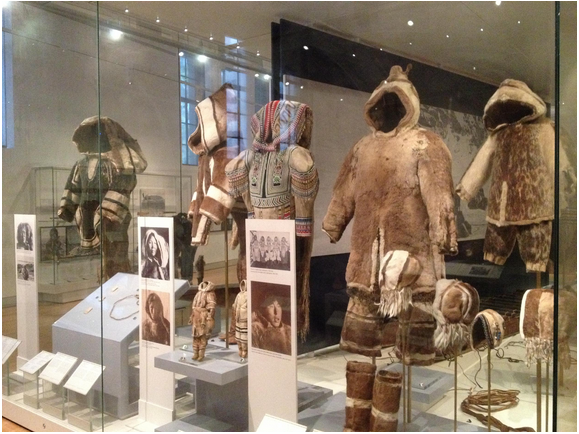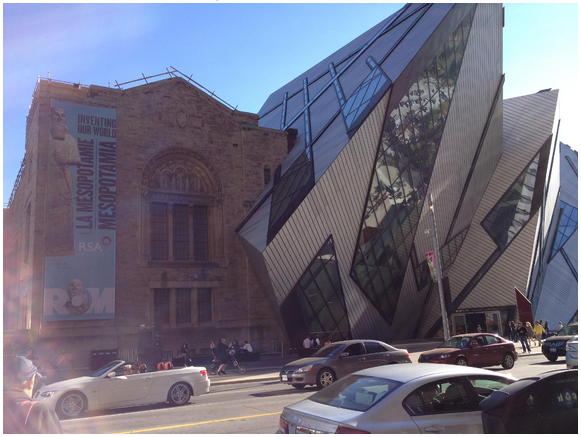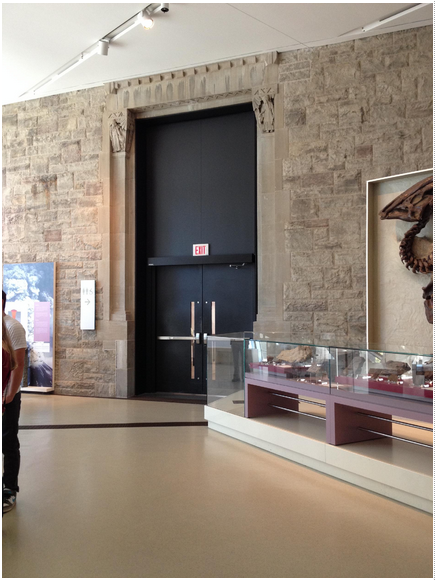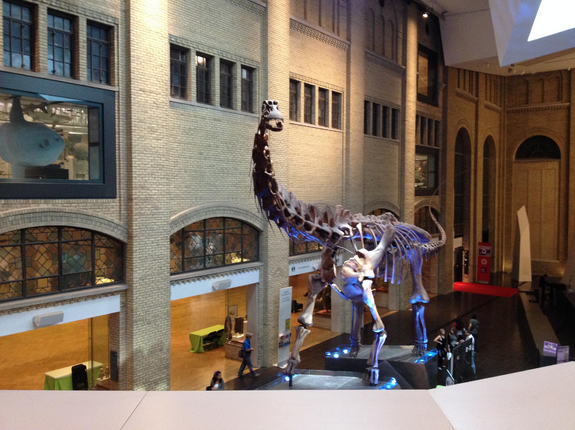by columnist Kacie Rice
One of my favorite things to do is when I travel is to see new museums, and I and a friend recently had a chance to visit Toronto’s Royal Ontario Museum (ROM), one of North America’s major natural history and anthropology museums. Founded in 1912, the museum serves over one million visitors a year and acts as Canada’s largest field research institution. ROM has a much more encyclopedic collection than we might expect of a typical natural history museum in the United States, more closely following the European model of the “cabinet of curiosity” than the American system of division between subject areas. In addition to dinosaurs, minerals, stuffed animals, and anthropology collections, the museum also houses arts from around the world and artifacts from Canadian history. The ROM’s collections are almost impossible to visit in a single day: in four hours, we weren’t even able to see half of the permanent exhibits – but what we did see was terrific!
The museum is housed in a split building – one side is the original 1914-1933 tan brick building embellished with Art Deco motifs, while the other side is an angular glass structure designed by Daniel Libeskind in 2007. The building’s schizophrenic Bloor Street façade is striking, providing a playful visual balance between the staid, immobile museum collections of the past and the dynamic, interactive exhibitions of today’s museum. Inside, the metal and glass of Libeskind’s structure abut the old building’s brick walls, which remain in place and continue to act as gallery dividers. The effect is fresh and interesting, though the angular walls sometimes create strange corners of wasted space and force the visitor to take peculiar, unintuitive pathways through galleries (this is particularly apparent in the dinosaur halls, where the confines of the building don’t always allow the exhibit pathway to proceed smoothly through geologic time).

A display of fur parkas in the Daphne Cockwell Gallery of Canada: First Peoples at the Royal Ontario Museum.

A touchscreen containing oral history videos in the Daphne Cockwell Gallery of Canada: First Peoples at the Royal Ontario Museum.
I was especially excited to see the galleries of Canadian history, which I’ve never had the opportunity to see displayed in a museum. This area was divided into two sections: one on the First Peoples, and one on Canada’s European colonial history. The First Peoples gallery contains artifacts from all over Canada, as well as oral history videos that give voice to Native Canadian stories and heritage. Designed with Native advisors, the gallery contains both historic and modern artifacts and artwork, bringing ancient cultures into the modern Canadian experience. Touchscreen video terminals are particularly effective in this gallery, as they allow First Peoples to have a literal voice, telling their oral histories verbally, the way they were meant to be heard. The European history gallery is also done well, containing furniture, art, and ephemera from the last 3 centuries of Canadian history (a lot of these artifacts echo what we might see in the American wing at the Museum of Fine Arts, Boston, except with key differences, e.g. beavers replacing eagles on armoires and dinnerware).
Another highlight at ROM is the Bat Cave, an immersive permanent gallery designed to look and feel like St. Clair Cave in Jamaica. The Bat Cave contains a series of dioramas of stuffed bats and utilizes light, sound, and even smell effects to mimic the feel of a real bat cave. I honestly think this was the first time I’d ever encountered smell effects in an exhibit – several areas of the gallery waft the smell of guano and bat urine to illustrate the pungency of the thousands of bats living in the cave. It’s weird (and gross), but extremely effective at creating the feeling of being underground among the bats. The Bat Cave is a really inventive way to bring life to natural history collections outside of the traditional diorama convention: when you enter the gallery, you enter the cave.
The museum also handles its inanimate objects well – in the geology hall, touchscreen collections browsers accompany the displays. These allow the visitor to choose an image of a specific gem or mineral and learn more about it, both giving depth of content and solving the issue of label overcrowding in a gallery containing hundreds of small artifacts sharing cabinet space. The touchscreens also free up the walls for more interpretive content on mineral classification and atomic structure that tends to be lost among copious tombstone information in other museums’ cluttered geology displays.
In terms of interpretive content, I was intrigued by the key differences I observed between the ROM and the American institutions I’m more familiar with. In addition to the obvious cultural markers, such as all labels being written in both English and French, I found some of the exhibits’ content to be more forward and direct than what we might display in the States. The most prominent example of this was in the Life in Crisis: Schad Gallery of Biodiversity. This gallery presents taxidermied animals from around the world with emphasis on the risk to these animals from human activity. The entire gallery is centered on the idea of human danger to nature – it’s right there in the gallery’s title! I’m not sure I’ve ever seen an American exhibit so bluntly and consistently state that humans are indeed causing major problems to world ecosystems. The exhibit also candidly says that humans are inarguably affecting climate change, a statement that would be considered politically charged and controversial in the American discourse. Honestly, it was refreshing to see a museum take a stand on science and dare to make visitors a little uncomfortable with the facts. I hope it has the intended effect in educating visitors on what they can do to help our ecosystems.
Overall, the ROM has a wonderful encyclopedic collection and an interesting, well-done set of permanent galleries. Its exhibits use technology well and inject thought-provoking content into fresh, relevant displays. As a Toronto institution, the museum seems well poised to educate and entertain the city for at least another hundred years. I hope to make it back one day to see the rest of the collections!



Leave a Reply